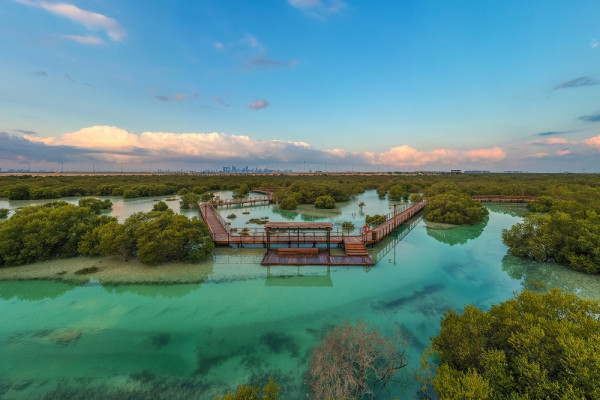
Around 350,000 mangrove seedlings have been planted on Abu Dhabi’s Jubail Island as part of an initiative to enhance the beauty spot by adding one million trees.
These are now part of the sprawling Jubail Mangrove Park. The million trees will help capture approximately 1,150 tonnes of carbon dioxide per year. The park covers about 19 square kilometres.
The planting programme is part of the UAE’s initiative to add 100 million mangroves trees by 2030 — a pledge made at the UN Cop26 climate change conference last November.
“Jubail Island spans more than 2,800 hectares, and in order to grow mangroves that will help improve the environment, we liaised closely with the Environment Agency Abu Dhabi to get their expertise on the best ways to expand the mangrove forest cover in the Emirate through planting more mangrove trees and protecting them,” said Abdulla Al Shamsi, corporate director of Jubail Island Investment Company.
“Their guidance and knowledge proved to be very useful, allowing the Jubail Island team to identify suitable planting sites, with some of these areas now already planted with seedlings.”
The work includes the addition of new channels to increase tidal flow into the wetland areas.
Royal visit
During a visit to the UAE by the UK’s Prince William this week, it was announced that the island will soon be the home of a new global hub for research and innovation in support of the conservation of mangroves.
:quality(70)/cloudfront-eu-central-1.images.arcpublishing.com/thenational/PXIRWNMNLZFO5NCIT33EOLDOHE.jpg)
:quality(70)/cloudfront-eu-central-1.images.arcpublishing.com/thenational/7NTJAX2THRF7PFPZ2ZSUFDJJ6U.jpeg)
:quality(70)/cloudfront-eu-central-1.images.arcpublishing.com/thenational/5IHJ3XDX2ZCVTALFO6RBNT5IUQ.jpg)
:quality(70)/cloudfront-eu-central-1.images.arcpublishing.com/thenational/K4TAOPEKHRGHJO4SLRIN543OW4.jpg)
:quality(70)/cloudfront-eu-central-1.images.arcpublishing.com/thenational/PU3522P3WVDUDMQX3O6WLXABEI.jpg)
:quality(70)/cloudfront-eu-central-1.images.arcpublishing.com/thenational/JUTXPA2ZXBDOLO7TY3PN7QHFHM.jpg)
:quality(70)/cloudfront-eu-central-1.images.arcpublishing.com/thenational/DHO3DOFTDRFWNDU2DJO5QV6VL4.jpeg)
:quality(70)/cloudfront-eu-central-1.images.arcpublishing.com/thenational/PFPX4MWL45BOZMDM6NFWXW6XTE.jpeg)
:quality(70)/cloudfront-eu-central-1.images.arcpublishing.com/thenational/OCEKDUAY2BHT7FFD4ETDPNBG7Q.jpeg)
:quality(70)/cloudfront-eu-central-1.images.arcpublishing.com/thenational/H2FDT4T3YJCXFPVCTTWTE32MZA.jpeg)
:quality(70)/cloudfront-eu-central-1.images.arcpublishing.com/thenational/NO4Y2IHEJJE4NGKQHNOOWMCXDI.jpeg)
:quality(70)/cloudfront-eu-central-1.images.arcpublishing.com/thenational/VCHMTLYK35AVFLR7HEXJH2SMXI.jpg)
:quality(70)/cloudfront-eu-central-1.images.arcpublishing.com/thenational/RSEOH2FOXFBV3F4KPHZR3ITR5U.jpg)
:quality(70)/cloudfront-eu-central-1.images.arcpublishing.com/thenational/5WWLAQX5JVDM7OE3PJY55ECLDQ.jpg)
:quality(70)/cloudfront-eu-central-1.images.arcpublishing.com/thenational/RQMC5OVKCJB5LAJCF3B4QADFVQ.jpg)
:quality(70)/cloudfront-eu-central-1.images.arcpublishing.com/thenational/NGAF4D5MXJVUF255OURPT5YJVE.jpg)
:quality(70)/cloudfront-eu-central-1.images.arcpublishing.com/thenational/GMCGTRCTZIJJHNCRVMZVJQVL6Q.jpg)
:quality(70)/cloudfront-eu-central-1.images.arcpublishing.com/thenational/OCUGO4EWM6PECSXDSVZ2AVN6HE.jpg)
:quality(70)/cloudfront-eu-central-1.images.arcpublishing.com/thenational/Z52MN47UDPJM26A6OF4XSVYCEI.jpg)
:quality(70)/cloudfront-eu-central-1.images.arcpublishing.com/thenational/KOKOWG6VFVA55I4U4GZIEOKQ2A.jfif)
:quality(70)/cloudfront-eu-central-1.images.arcpublishing.com/thenational/U4HVMDIF55DJLDPJYAY43UCRL4.jfif)
:quality(70)/cloudfront-eu-central-1.images.arcpublishing.com/thenational/KETHTC5MC5FGXAM7SAG5BAL4FE.jpg)
:quality(70)/cloudfront-eu-central-1.images.arcpublishing.com/thenational/4NMBFOQ34ZHUZBXMANTGID4CBQ.jpg)
:quality(70)/cloudfront-eu-central-1.images.arcpublishing.com/thenational/XG6KCK3WIRDTBDRPBLQXOJ7LNQ.jpg)
:quality(70)/cloudfront-eu-central-1.images.arcpublishing.com/thenational/A4P7ERSFZVBVBNAZZFAZXUGO4E.jpg)
:quality(70)/cloudfront-eu-central-1.images.arcpublishing.com/thenational/LVK5MGUHOZGU7PTR2XYEQ4VMNI.jpg)
:quality(70)/cloudfront-eu-central-1.images.arcpublishing.com/thenational/H6XQS3MJO5HFVEEU2INWWJZ3WU.jpg)
:quality(70)/cloudfront-eu-central-1.images.arcpublishing.com/thenational/AGLXA3BG2ZBQBKCARSCL3MZIPE.jpg)
:quality(70)/cloudfront-eu-central-1.images.arcpublishing.com/thenational/7OXWRQSI3ZCONHNMRNHVSM6ELA.jpg)
:quality(70)/cloudfront-eu-central-1.images.arcpublishing.com/thenational/MP2QME2HW5HEVAREGXJUVZLTK4.jfif)
:quality(70)/cloudfront-eu-central-1.images.arcpublishing.com/thenational/HZDEDSOLYVBMPDCDSRSHFAWWS4.jpg)
:quality(70)/cloudfront-eu-central-1.images.arcpublishing.com/thenational/FAD3V62VX5GHDOPTSXN7JOVSOA.jpg)
:quality(70)/cloudfront-eu-central-1.images.arcpublishing.com/thenational/RUGQZ73ZUVDMJKNC7VEHF3Y25I.jpg)
Prince William plants mangrove seedlings with pupils. Victor Besa / The National
The Abu Dhabi Mangrove Initiative, which will be implemented by the Environment Agency Abu Dhabi, has already secured its first partnership — with the Zoological Society of London. It will field-test different approaches with the aim of bolstering mangroves for future generations.
The Duke of Cambridge learnt more about the project on Thursday, when he helped plant saplings at the site with Abu Dhabi school pupils.
Mangrove forests help protect the UAE coast from the effects of rising sea levels and storms. Extreme weather is becoming more frequent due to climate changePrince William visit: Abu Dhabi announces major mangrove conservation project
They also act as a carbon reservoir — or sink — preventing carbon from entering the atmosphere, which is a major contributor to global warming.
Though much smaller in size than the planet’s forests, these coastal systems sequester carbon at a much faster rate and can continue to store it for thousands of years.
It is estimated the long-term sequestration of carbon by one square kilometre of mangrove area is equivalent to that occurring in 50 square metres of tropical forest, according to the authors of a book about the UAE’s salt flats.
:quality(70)/cloudfront-eu-central-1.images.arcpublishing.com/thenational/DNK46KJL4KI2HIFPT3ZJ73DJOU.jpg)
:quality(70)/cloudfront-eu-central-1.images.arcpublishing.com/thenational/LIVWBJWHKZD74DOZATEBPCGHOI.jpg)
:quality(70)/cloudfront-eu-central-1.images.arcpublishing.com/thenational/T7U54SEGZP7IIAR7STTJR44J6M.jpg)
:quality(70)/cloudfront-eu-central-1.images.arcpublishing.com/thenational/WKKCFR4FFGOT7ATFUBSALA3OHY.jpg)
:quality(70)/cloudfront-eu-central-1.images.arcpublishing.com/thenational/GGUO3QPHRMIFJKVQULQ2SWBE2I.jpg)
:quality(70)/cloudfront-eu-central-1.images.arcpublishing.com/thenational/BXFZMEPP3WK773HDG77TVLI75A.jpg)
:quality(70)/cloudfront-eu-central-1.images.arcpublishing.com/thenational/B7TIN2D5I5IS3MHZIH44UKT3XI.jpg)
:quality(70)/cloudfront-eu-central-1.images.arcpublishing.com/thenational/NDYQTMF7LQFWEZ2XSVZVAW7UBE.jpg)
:quality(70)/cloudfront-eu-central-1.images.arcpublishing.com/thenational/5RLVYOS7RILOODI4EHP6DZDYU4.jpg)
:quality(70)/cloudfront-eu-central-1.images.arcpublishing.com/thenational/CNYSCJQEQIC2KKJ3YEPDNYE6OM.jpg)
:quality(70)/cloudfront-eu-central-1.images.arcpublishing.com/thenational/YW5WFFEOBFAIPEVOMTKGHTDT3U.jpg)
:quality(70)/cloudfront-eu-central-1.images.arcpublishing.com/thenational/HH6NZBGRRFXR47GBWEZPV23DL4.jpg)
Kayaking on the pristine waterways of the mangroves on Jubail Island, off Sheikh Khalifa Bin Zayed Highway and less than 15 minutes from Abu Dhabi.
Plans for the island
Parts of the 45-square-kilometre island are currently under development for a low-density housing project.
“We are on track to complete the first phase of development by the second quarter of 2024,” Mr Al Shamsi said.
The first phase, which will be handed over this June, has already sold out, he said.
“The initial tranche of approximately 300 villas is set to be delivered by the end of 2023. In addition, building works are progressing, with over 128 villas in Nad Al Dhabi village alone.”
The island will eventually have six villages, with homes for more 5,000 residents.
“Residents [will be] able to look forward to a redefined way of living in breathtaking picturesque areas, along with excellent community facilities such as shopping malls, schools, supermarkets, nurseries and restaurants,” Mr Al Shamsi said.


